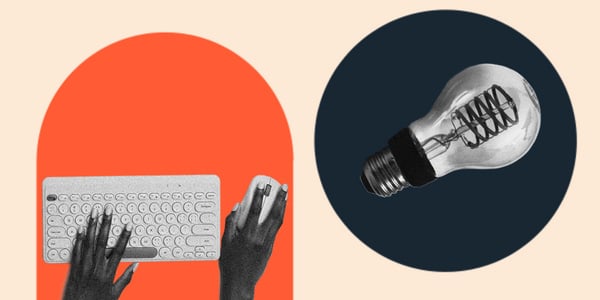If you're new to UX design, the first thing you should know how to do is create a UX persona. UX personas are one of the cornerstones of design, and they play a crucial role in helping you find design solutions and create user-friendly products and experiences your customers appreciate.

In this guide, you'll learn what a UX persona is, how to create one, and some tips you should keep in mind as you make a UX persona.
Table of Contents
- What is a UX Persona?
- Why UX Personas Matter
- How to Create a UX Persona
- Examples of UX Personas
- Tips for Creating a UX Persona
What is a UX persona?
A UX persona is a semi-fictional character that represents the wants, needs, and traits of a subset of your target audience. These personas are based on an in-depth analysis of your actual customers and their behavioral patterns, background information, skills, goals, and problems.
In UX, personas help you identify key patterns and themes among your ideal customers, which makes it easy for you to empathize with your audience and make better product decisions.
A well-designed UX persona contains the following:
- A fictional name.
- An image (e.g., illustration, avatar, or photo) of the persona.
- A real quote that summarizes what the persona is most concerned with as it relates to your product.
- The demographic profile, including the persona’s age, gender, employment status, family status, and any other information that’s relevant to your product.
- Psychographics, including the persona’s attitudes, interests, pain points, and motivations.
- End goals (what the users want to accomplish by using your product).
- A scenario that details how a persona would interact with your product to achieve their goals. This scenario is usually written from the persona’s point of view and describes use cases for which they may need your product.
All this information is kept in an easily accessible document or presentation deck you can reference when you need to.
Pro tip: If you’re creating multiple UX personas to represent different user segments, you can assign each persona a tagline or label. This distinguishes between the different personas and succinctly indicates which user group each persona belongs to.
For instance, if you have two personas who have different shopping attitudes, you may tag them “The Thrifter” and “The Luxury Shopper,” respectively.
Why UX Personas Matter
Maria Harutyunyan, the co-founder of Loopex Digital, uses UX personas to inform the strategies her teams execute in the business. On the importance of UX personas, Harutyunyan says, “UX personas matter as they represent the people we want to reach with our design. By getting to know their behaviors, desires, needs, and motivations, we can provide the best solutions for them.
“In SEO, especially, understanding our users allows us to create content and strategies that truly meet their unique needs. When we do this well, we see better user engagement, satisfaction, and, ultimately, more conversions.”
Harutyunyan goes on to give an example of a UX persona she used in her agency.
“While working on a project for a client selling eco-friendly products, we discovered through research that one of our key user groups was environmentally-conscious millennials,” says Harutyunyan. “So, we created a persona named ‘Eco-Friendly Emma,’ a 28-year-old urban dweller passionate about sustainable living. This persona helped guide our SEO strategy, ensuring the content we created resonated with users like Emma.”
When done well, UX personas can work for different kinds of businesses, including yours. Here are four reasons why you should use them.

1. Understand your users.
UX personas represent real people — their likes, dislikes, attitudes, habits, pain points, and more. The descriptive nature of these personas enables designers to understand their ideal customers.
They also help designers empathize with the issues their users face and how these issues affect how they interact with the product.
2. Make better product decisions.
UX personas highlight what’s important to your users and what they need from your product. This helps designers craft a UX strategy that’s centered around features and solutions that users will appreciate.
Understanding your users’ pain points, goals, and motivations will help you figure out what changes will make the most positive impact on your users’ experience with your product.
3. Improve user-centric design.
Think of UX personas as a compass that alerts you when you’re making the wrong decisions and steers you back on the right path.
When you consult your UX personas often, you won’t design a product based on what you think it should look like. Instead, you’ll design a product that is tailored to your ideal customers, their capabilities, and their needs.
For example, having a clear understanding of your customers’ behaviors and preferences can help you create a user-friendly interface that your users can operate easily. This user-centric design makes all the difference between an app that just looks attractive and one that meets customers’ expectations and fulfills their needs — the latter being crucial for attracting and retaining users.
4. Align your UX strategy.
To ensure alignment across all aspects of your design process, you need a well-crafted UX persona.
By creating detailed and research-based UX personas, designers are better equipped to understand the behaviors, needs, and pain points of their target audience. This informs their decisions on which features and functionalities to prioritize, how to structure their site hierarchy, what color palettes to use, and other design elements that will impact user experience.
UX personas ensure that everything the design team does contributes to the ultimate goal of satisfying the end users in every way possible.
How to Create a UX Persona
Crafting UX personas is an iterative process. You create them before you start designing and then update them as you gather new data.
Below are the main steps you need to follow to create a foundational UX persona.

1. Conduct user research.
The first step to creating a UX persona is to collect data about your users (or prospects). You can do this through qualitative and quantitative research methods.
Qualitative research methods include user interviews, contextual interviews, focus groups, and usability tests — all of which give you the chance to ask your target audience some questions about your product (or watch them use the product) and receive in-depth information about their experience with it.
Quantitative research methods include sending out online surveys and analyzing web analytics, including the number of page visitors, time spent on site, and the journey visitors go on before they convert to paying customers.
The responses from the surveys give you deeper insights into the demographics, psychographics, behavioral patterns, challenges, and needs of your customers, which is vital information you need to make the best design decisions.
Pro tip: If you have enough time and resources, use both research methods to get a more accurate and balanced result.
2. Organize your research.
After conducting your market research, try to find commonalities and patterns that allow you to identify different types of users, i.e., how different user types behave and use your product.
This process will vary depending on the kind of research you conducted. With qualitative research, you can use a Notes app or a word frequency counter to visualize data and group users who follow similar themes.
For example, if you notice that a large number of users you spoke to have the same pain point or goal, you can put them in one category. Or you can analyze the written answers from your survey respondents to find commonalities in the words they use, their interests, hobbies, or personal information, such as age or gender.
For quantitative research, however, you can visualize your data with charts and graphs. These will clearly show you any trends or patterns you should consider as you create your UX persona.
3. Decide on a number of personas.
Now that you have a better understanding of your user groups, identify which ones are the most important and prioritize them throughout the development process.
Ideally, you should have 1–4 main user groups. For each one, create a clearly defined UX persona that’s distinguishable from the others. You can define each one by their ages, backgrounds, technical ability, or even their motivations for using your product.
A great way to distinguish between multiple UX personas is to place them in primary and secondary categories. A primary persona is the most relevant persona that represents users who actually interact with your product.
Secondary personas, on the other hand, are users that may have additional needs that you need to adjust your product to meet. The adjustments, however, should not affect the experience of primary users.
For example, users who are disabled or have limited technical abilities are secondary users because you need to make your website accessible to them.
4. Describe your UX persona.
Now it's time to actually set up the UX persona. Use your research to define the key details about your ideal user as they relate to your product. You can structure your findings in several ways, but ensure you include the following elements:
- Name: Instead of something vague like “User 1”, create a fictional name to make your persona feel more realistic and memorable.
- Image: Use a stock photo or a digital illustration of a person to represent your persona. This helps you empathize with them and makes it easier to imagine them in various product-related use cases.
- Demographics: Specify the age (or age range), family status, employment status, education, background, and technical ability of your persona. This information should be based on research.
- Psychographics: Here, specify the behaviors, pain points, goals, and needs of your persona. This will help you understand your users’ motivations and reasons for using your product.
- A quote: This is a concise statement that sums up the most important thing to your user persona as it relates to your product. Base this quote on research by imagining how your persona would describe themselves if they were a real person.
Pro tip: Put your UX personas in a well-designed document to make it accessible to your team members and other teams that need it.
5. Share (and use) your UX persona(s).
Once you’re satisfied with your UX persona(s), share it with other teams so that other people can get to understand the users they’re trying to serve.
During the design process, refer back to your persona(s) and include it in discussions about the product. Before making a critical design decision, ask yourself, “Will this benefit my UX persona?” Doing this helps you put your users first and create a product that meets their needs.
As your product evolves, revisit and tweak your UX personas to keep them current. This may mean adding new personas, scrapping existing ones, or just making small changes accordingly.
Examples of UX Personas
Now that we’ve covered the process of creating a UX persona, here are two UX persona examples that can inspire your own.
These personas are for a healthy food delivery app that delivers to Illinois residents.
1. John Michaels, a University Student
Fictional Name
John Michaels
Occupation
Part-time coffee barista, undergrad University student
Demographics
- 20 years old
- Lives in Chicago
- Single, no children
- Has two roommates who work part-time
Goals and Needs
John doesn’t know how to cook. But he’s health-conscious, so instead of eating junk food, he prioritizes eating healthy foods, especially proteins, fruits, and salads, at optimal times throughout the day.
John’s schedule is tight, and he mostly spends time at school or at the coffee shop where he works. Leaving the shop to get food can disrupt his schedule (and pay), so he needs a way to get healthy food without risking those things. His best bet is to order it.
Pain Points
John isn’t tech-savvy, so he needs an app that clearly displays the available dishes, along with the prices and any add-ons. He’ll also appreciate a quick and easy payment process and fast delivery.
Personality
“Doing hard things favors no one. If there’s an easy way out, take it. It’s all the same in the end.”
2. Hannah McCoy, software engineer
Fictional Name
Hannah McCoy
Occupation
A full-time software engineer who works from home, a part-time business consultant
Demographics
- 42 years old
- Lives in Chicago with her 44-year-old husband
- Married with two young children
- Has a high-income level and a profitable business
Goals and Needs
Ever since she started reading about the lack of quality ingredients in processed foods and juices, Hannah tries to make time each day to cook healthy meals for her family. However, she just started her consulting business while working a full-time job as a software engineer, so she’s really busy.
Despite her tight schedule, Hannah refuses to give her family junk food and processed meals. She needs a reliable restaurant that can deliver healthy foods in bulk to her Chicago residence.
Pain Points
Most food delivery apps that Hannah has checked out don’t offer healthy salad bowls, and the few that have salads on their menu don’t deliver in bulk. Hannah would appreciate a restaurant that can deliver healthy meals that can last at least four days.
She’d also love it if they could deliver pre-made veggies to her so she won’t have to go to the grocery store often.
Personality
“Doing everything all at once saves time and stress, especially if you’re a busy bee.”
Tips for Creating a UX Persona
As you create your UX persona, here are some tips you should keep in mind.

1. A UX persona goes beyond demographics.
While demographics are an important part of creating a UX persona, it shouldn’t be your entire persona. UX personas should be based on your users’ behaviors, goals, and motivations, rather than their age and job title.
Knowing that your ideal buyer is a middle-aged full-time project manager who runs a side hustle is useless if you don’t know what’s stopping them from subscribing to your product.
2. Don’t make up personas.
It can be tempting to just whip up a UX persona based on your (or your superiors’/colleagues’) understanding of your product and the market. But this can be detrimental because you’ll end up creating a product that’s for you (or the person whose ideas you’re basing your persona on) and not for your users.
Good UX personas should be based on real insights you get from communicating with your target audience.
3. Keep an open mind.
This ties nicely with the previous point. During your research, you might be surprised by the answers your target audience is providing, especially if they don’t coincide with the company narrative. In cases like this, you need to keep an open mind.
“When creating UX personas, researchers should avoid bias,” says Leizel Laron, the UI/UX designer at Exaweb. “It is important to refrain from creating demographics that favor the product, as doing so can result in unreliable feedback and outcomes.”
You’re not the customer. Take a step back and let user insights guide you.
4. Talk to your user base in person.
Sending out online surveys for your target audience is a great way to get detailed answers to your questions. But if you want to get a deeper knowledge of your users, your best bet is to speak directly with some of your actual customers (or site visitors) face-to-face or via video chat.
This helps you get raw, unedited answers you can use to expand on what you have already built.
5. Collaborate with other teams.
While UX personas are mostly used by the design team, other departments, like marketing and product, may need to reference them while creating business strategies. So make your UX persona(s) available to them.
As Daniel Chabert, the CEO and co-founder of PurpleFire, put it: “Encourage cross-functional collaboration, including input from design, development, and marketing teams, to build a unified understanding of user needs.”
Create Effective UX Personas
UX personas turn the abstract concept of a customer into a (semi) real person with preferences, emotions, and personality. Because of this, design teams have something tangible that they can refer to when making decisions on the direction the product will go.
These personas help the design team avoid generalization and focus on the target audience instead, allowing them to create user-centric interfaces and tailor the product features to meet the users’ specific needs.





![Website Navigation: The Ultimate Guide [Types & Top Examples]](https://knowledge.hubspot.com/hubfs/ft-nav-bar.webp)
![What Is End-User Experience Monitoring? [+Tips For Implementing It]](https://www.hubspot.com/hubfs/end-user-experience-monitoring.png)




